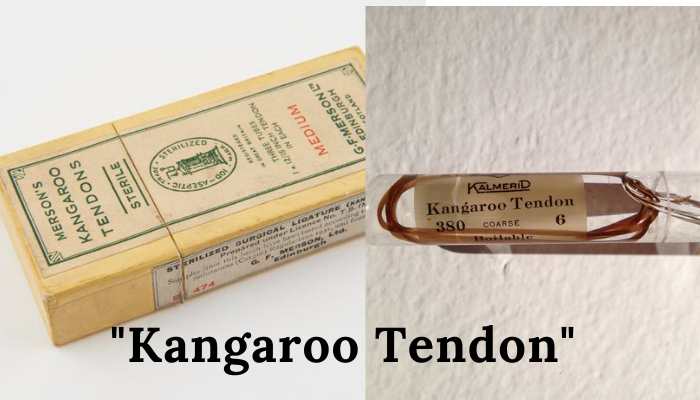Kangaroo tendon sutures
Kangaroo tendon suture is obtained from the tendon of tail of kangaroo and is used for suturing joint capsule, hernial rings and places where more strength is required. Kangaroo tendon is approximately 6 times stronger than human tendon.
Source
Kangaroo tendon is not obtained from large kangaroo but a wallaby / wallabee hence it was plentiful and economic especially in the Australia with unlimited supply. But not it is comparatively scarce and expensive due to less availability of the raw material. Tendons from a freshly killed small kangaroo or wallaby are sundried, separated, cleaned and dried straight in order to make sutures.
Tensile Strength
It has a high tensile strength, so it can be used in slow healing tissues or where greater strength of the suture material is required, such as in joint capsule or for hernia repair. Kangaroo tendons were introduced as suture material as a substitute of catgut. Catgut becomes weak after fluid absorption from the tissue or become moist but kangaroo tendons are many times stronger than the same size of catgut suture.
Absorption
Kangaroo tendon is invaded by the wandering cells; new vessels are formed between the strands of the tendon and latter become ultimately a living piece of fibrous tissue and part of host or patient. So a marked thickening of the tissue can be observed along the line of buried sutures for a considerable period longer. It has been used for buried sutures and well tolerated by the tissues (can be found in the tissue years after the use).
Characteristics
Kangaroo tendon is very strong, less slippery, easy to handle, have better knot security than catgut and it can be made or the required sizes. It can be preserved for longer time in a strong antiseptic solution. Sinus formation is also lesser in the use of kangaroo sutures as suture material. Unlike catgut it doesn’t need treatment with chromic acid. But they can be chromicised by immersing them into solution of potassium dichromate for varying lengths of time and then preserved.
Uses
Kangaroo tendon in surgery is used as xenograft for procedures like orthopaedic for joint capsule repair (knee, ankle, and shoulder), reconstructive ligament surgeries (anterior cruciate ligament or ACL repair). It has been used extensively in the use of hernia repair as mattress and interrupted suture pattern. Kangaroo tendon has also been used for the surgery of shortening of ocular muscles.
It is not used in plastic surgery but has been reported to be used in mandible fracture repair in a few studies rather than using silver wire.
Limitations
Kangaroo tendon sutures can’t be sterilized with the heat but sterilization can be achieved by soaking them into alcoholic solutions like carbolic acid, dichloride or iodide of mercury and can be preserved in such mediums (sometimes in boiled linseed oil or chloroform.
Sizes
Size ranges from fine, medium to heavy. Average length is about 12 inches.
FAQ
Kangaroo tendon has a similar composition to that of human tendon, high tensile strength (6 times) and best suited natural suture material for tendon repair and joint capsule surgeries. They can be preserved for very long time. In initial times it was far better than catgut suture or available natural suture materials for joint capsule repair and hernial repairs.
No, Use of kangaroo tendon is limited in joint or orthopaedic surgeries (joint capsule repair) and ligament/tendon repairs. Synthetic material and implants are more frequently used. It is more popular as a treat for dogs in recent times.
